Over the past two years, I’ve gone through a half-dozen pairs of wading boots. The first few pairs were cheap - what I could afford at the time - but as I started fishing more and more, I began to realize the need for a solid, dependable boot that wasn’t going to cost me more than I’ve ever spent on a fly rod ($365 on an antique bamboo rod that was just too perfect a deal to pass up).
That’s when I turned to Korkers. One my best fishing buddies fishes Korkers religiously, and between that and their pricing, I had all the endorsement I needed to give them a try.
I originally bought a pair of the Korkers Redsides, and they disappointingly wore out after about 6 months of heavy use (I fish around 175 days a year). But, thanks to some absolutely stellar customer service on Korkers’ end, I was upgraded to the Devil’s Canyon boots, and have been fishing them hard ever since.
They’ve taken all the abuse I have thrown at them, and then some. From wading freestone streams, boulder hopping, and scrambling down narrow canyons to fishing skinny water, the boots still look and feel brand new. According to Korkers, the Devil’s Canyon boot is designed to “deliver athletic and agile performance” - which is something those of us who venture far off-trail into the backcountry demand out of wading footwear. And after a solid testing period, I can firmly stand behind that bit of marketing from Korkers. The boots have an excellent fit, provide stability on slippery rocks and in swift current, and at $200, represent a serious value.
What works
Weight
One of the first things you’ll notice about the Devil’s Canyon boots are how light they are - 2lbs, 14oz per pair, according to Korkers’ website. A light, nimble boot is a must-have for anglers who find themselves walking 2-3 miles into a canyon before gearing up to fish. A lot of my fishing involves hauling a day pack stuffed with boots, waders, and other gear, to the river. Cutting down on the weight of my wading boots has made a huge difference in pack weight, and how sore my back is after a hard day of hiking and fishing.
BOA system
These boots do feature the BOA lacing system, which is a favorite among a lot of anglers. I moved to BOA from a drawstring and laces, so it’s been like moving from a $20 Wal-Mart fly rod to a Sage One in terms of functionality and durability.
Agility
Most wading boots are stiff, and they’re built that way on purpose - to give you as sure a footing as possible when in the water. But the Devil’s Canyon boots have found a way to meld stability with agility, making a book that’s a pleasure not only to wade in, but to walk in as well. They flex well with movement, and it’s nice to have that sort of agility when navigating really rocky streambeds.
OmniTrax
Korkers’ biggest selling point on all of their boots is their OmniTrax system, which allows anglers to swap out the soles of the boots. Currently, they offer rubber, felt, studded rubber, and studded felt soles that can easily be swapped out depending on what type of river you’ll be fishing in that day.
It's also worth noting, for those that may have tried Korkers' interchangable soles in the past, that their latest incarnation is a stark improvement over earlier iterations. Gone are the inset soles that only reach to within about an inch of the boot's sole edge and that lack a uniform, cohesive sole surface. Kokers' current incarnation of OmniTrax is a interchangable full sole, not an interchangable portion of a sole.

Durability
Korkers designed these boots with as little stitching as possible, a reinforced toecap and rough, abrasion-resistant material. The first day I took the boots out, I dragged one pretty roughly against a sharp tree branch. I fully expected to see a tear in the boot, but I didn’t see a single scratch. A few weeks later, the boots still look brand new. Granted, I can’t vouch for their long-term durability, but after a few weeks of heavy use, I’m impressed with how well they’ve withstood the abuse they’ve been put through.
Comfort
Lastly, these boots are pretty comfortable. Korkers provides a sizing chart on their website, which is useful, but I’ve found that with both pairs that I’ve ordered from them, it’s best to order a boot in the same size shoe you wear. Unless you have waders with really thick neoprene booties, you should have a snug fit ordering a boot in your same shoe size. The upper part of the boot is built with a neoprene-like material that fits glove-like over your leg, which improves both the agility and comfort of the boot.
What doesn’t work
No gaiter hook ring
The first thing I noticed when putting these boots on was that there wasn’t a place for the hook on my waders’ gaiters to hook onto the boot. I asked Mark Fuller, a customer service rep for Korkers, about the lack of a gaiter hook ring, and this is what he said:
“We’ve had a lot of feedback through the years from both consumers and retailers alike regarding the gravel guard ring. We’ve found that there’s a large variance of gravel guard types and sizes (as well as foot shapes), so we decided to simply remove the ring to accommodate this. We recommend that the angler simply attach the gravel guard clip anywhere on the BOA cable lace.”
I’ve done as Mark suggested, and so far haven’t noticed any wear on the BOA cable laces. But only time will tell if that’s a legitimate solution.
Thin material
In an effort to cut weight, Korkers built these boots with a thinner material than their K-5 Bombers, or other boots in their lineup for that matter. So far, they’ve held up to fishing abuse, but I am concerned with how well the thinner material will stand the test of time.
Stability could be better
While I do love how light these boots are, there were times when a little extra weight would have been nice while wading in stiff current. But this is really a nitpicky complaint - 90% of the time, the boots were plenty stable for the fishing conditions I was in.
Final Word
At $200, Korkers has built a boot that’s incredibly lightweight, agile, comfortable, and looks great. The BOA system is certainly a nice touch, and I think at this price point, Korkers has built an impressive offering. I’d highly recommend these boots for anglers who spend more than 100 days a year on the water, particularly anglers that do a lot of hiking and/or backcountry fishing.
Learn more about the Korkers Devil's Canyon Boot at Korkers.com.





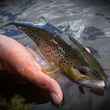





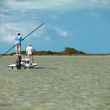









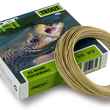
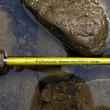







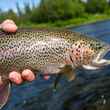
Comments
KG replied on Permalink
I also gave these boots a shot. As a fishing guide in Southern BC my gear gets beat up pretty quick. I was a little nervous when I felt how light these boots were!
Cons:
- Very little ankle support. They are ultra flexible and even have neoprene along the spine whereas a Simms boot would have plastic reinforcement. If you're wading through massive rock gardens or hiking in rough terrain, this is not the best boot out there.
- The Klingon sole is Korkers rubber sole. I chose this sole the very time I wore these boots as I have had good experiences on the Vibram equivalent. In this case though I almost killed myself out on the river! Unless your riverbed is gravel, do not use the Klingon sole for wading! They are very very slippery and I am not kidding around here. The Klingon sole is great for the part where you are hiking to the river, once there swap it out for the felts or the studded version!
Pros:
- As mentioned, the price is great.
- Sole interchangeability, awesome. Felt wears rapidly, when they are toast, get a new set of soles and you're good to go again.
- Durability. I've had these for two seasons now and they're still holding strong!
Korkers really did a good job with these, they are highly recommended!
Spencer Durrant replied on Permalink
I'm really glad to hear that they've held up to you, as a guide, for two seasons!! I agree about the rubber soles, I almost always use the studded rubber or felt (of course, only in waters that are disease free) when I'm out wading. The ankle support could be better, but hey - for how light these boots are, I'll take it. I just got back from fishing this morning, actually, and I'm still stoked at how nice they are.
James savstrom replied on Permalink
My Korkers with the wire ties. wore out completely in one season. The replacement wires were impossible for me to install, so I bought some new Korkers with regular laces. They are great for hiking and wading, but mine are studded, and I won't go any other way. I hate swimming...
Except in Mexico...
Pages